Kagoshima, a prefecture in southern Japan, is renowned for its unique soba noodle tradition. Visitors can enjoy this culinary experience, crafting authentic Kagoshima-style soba using locally-sourced buckwheat flour. Through a hands-on workshop, you will learn the intricate techniques of kneading, shaping, and cutting the dough to create fresh, flavorful noodles. But the true essence of this experience lies in the opportunity to savor the local flavors, tailoring the soba dish to one’s personal preferences. Discover the rich heritage and taste of Kagoshima’s soba culture.
Key Points
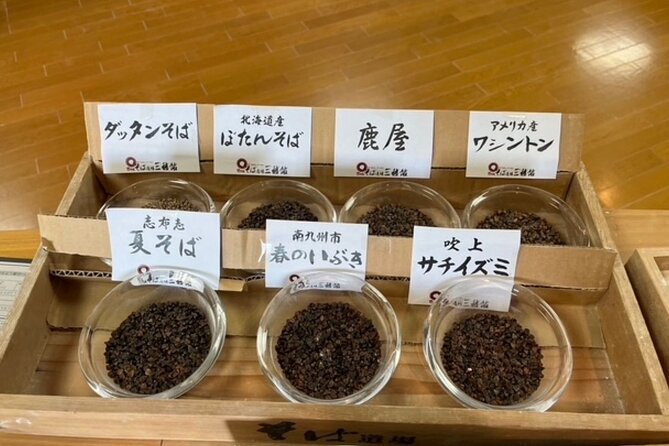
- The workshop focuses on traditional soba noodle production, allowing participants to learn the process of kneading and folding buckwheat dough.
- Participants will experience the hands-on process of rolling, cutting, and shaping the soba noodles, emphasizing uniformity and delicacy.
- Fresh soba noodles are boiled, drained, and served with a choice of dipping sauces, such as traditional tsuyu or mentsuyu.
- Participants can customize their soba noodle experience by adding toppings like tempura and spring onions and adjusting the serving style to be either cold or hot.
- Participants receive a cold storage bag to transport the freshly made soba noodles home, allowing them to enjoy the authentic Kagoshima-style soba noodles.
Exploring the Kagoshima Soba Noodle Experience
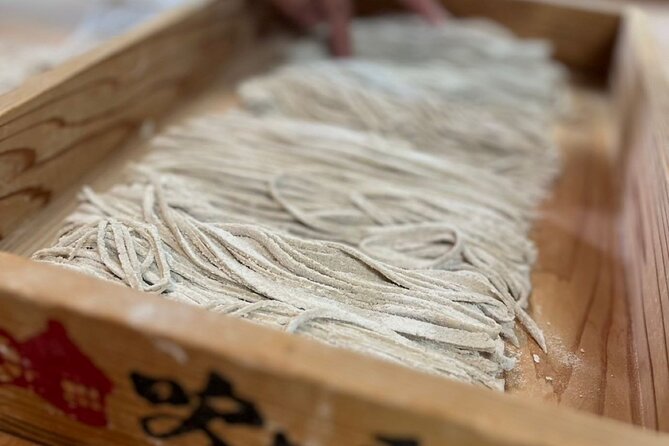
Nestled in the heart of Kagoshima Prefecture, Japan, the Kagoshima Soba Noodle Making experience offers travelers a unique glimpse into the art of traditional soba noodle production.
For $25.57 per person, visitors can create a plate of soba that serves four. Hosted by local experts, the hands-on workshop teaches participants the intricate process of kneading, rolling, and cutting the buckwheat dough into delicate noodles.
With a maximum of 12 travelers, the intimate setting allows for personalized guidance. Regardless of ability, anyone can join this immersive cultural experience, though wheelchair access is limited due to steps at the location.
You can also read our reviews of more tours and experiences in Kagoshima Prefecture.
Preparing the Soba Dough
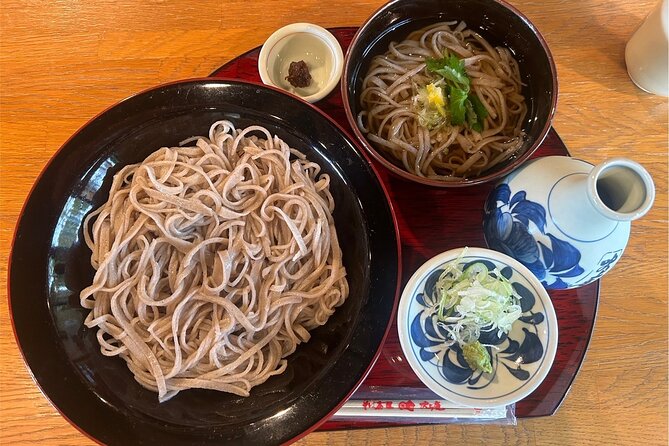
The Kagoshima Soba Noodle Making experience begins with the preparation of the soba dough.
Participants learn the traditional technique of kneading and folding the dough. They mix buckwheat flour, water, and salt, then knead the mixture until it forms a smooth, elastic dough.
After resting, the dough is rolled thin and cut into long, thin noodles. The process requires precision and patience, as the dough must be the right consistency to produce the perfect chewy texture.
With guidance from the experienced instructors, travelers master the art of soba dough preparation, a crucial step in creating authentic Kagoshima-style soba noodles.
Kneading and Shaping the Soba Noodles
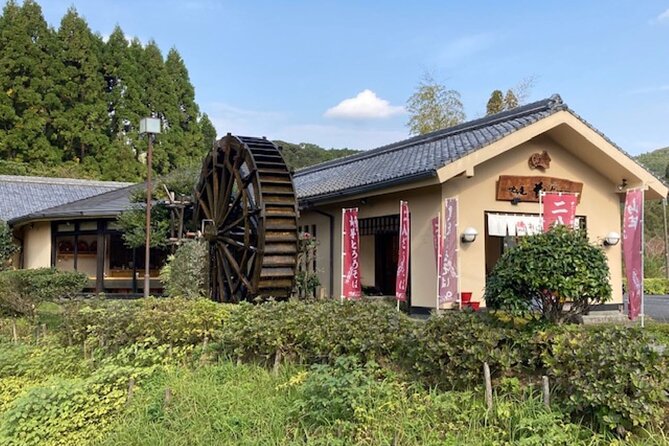
With the soba dough prepared, participants dive into the intricate process of kneading and shaping the noodles.
They gently knead the dough, folding and pressing to develop the gluten. Then, they use a rolling pin to roll the dough into thin sheets.
Skillfully, they fold the sheets and slice them into long, thin noodles. The rhythmic slicing produces uniform, delicate soba strands.
Participants marvel at transforming simple ingredients into authentic Japanese noodles. This hands-on experience allows them to appreciate the craftsmanship and tradition behind every bite of Kagoshima soba.
Cutting the Fresh Soba Noodles
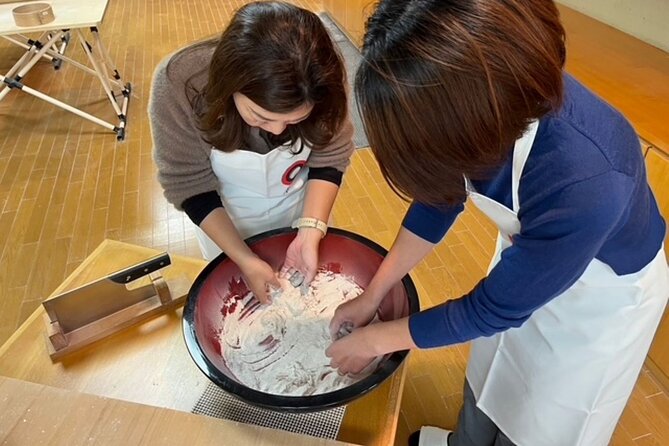
Participants delicately slice the thin, rolled dough into long, uniform soba noodles. Using a traditional soba-kiri (soba cutting) knife, they carefully cut the dough into evenly-sized ribbons. The noodles are then lightly floured to prevent sticking.
| Step | Action |
|---|---|
| 1 | Divide the dough into smaller sections |
| 2 | Roll each section into a thin sheet |
| 3 | Slice the sheet into long, thin strips |
After cutting, the fresh soba noodles are ready to be cooked and served. This hands-on experience allows travelers to fully appreciate the artistry and tradition behind authentic Kagoshima soba.
Boiling and Serving the Soba Noodles
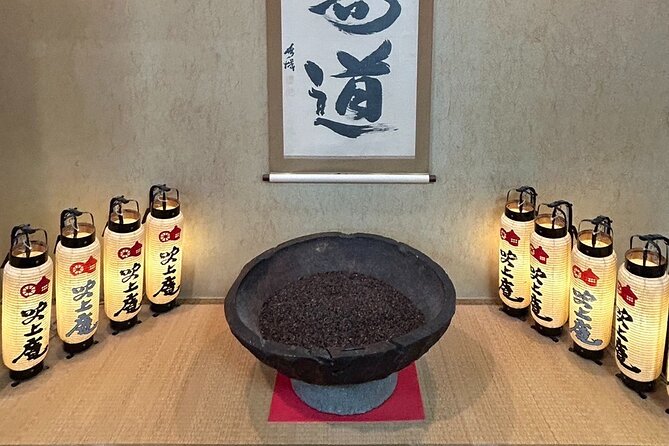
Next, the fresh soba noodles are boiled in hot water.
The you will carefully lower the long, thin noodles into the pot and let them cook for a few minutes until they’re tender yet still firm.
Once the noodles are ready, they’re drained and rinsed under cold water to stop the cooking process.
The noodles are then arranged on individual plates or bowls, often served with a dipping sauce on the side.
Diners can then pick up the noodles with their chopsticks, dip them in the sauce, and enjoy the authentic flavors of handmade Kagoshima soba.
- Climb the Rocks of Yakushima! Outdoor Bouldering Rental Mat
- 4 Hour Guided Cycling Experience in Yakushima
- Shiratani-Unsuikyo Trekking Tour in Yakushima Island
- [Sdgs Workshop] Satsuma Kiriko Pendant Experience – From Waste Glass Materials
- Private Tour: Full-Day Walking Tour With Professional Local Guide in Yakushima Island
- Pasture Hike With Horse Whisperer at Horse Trust in Kagoshima
Savoring the Local Flavors
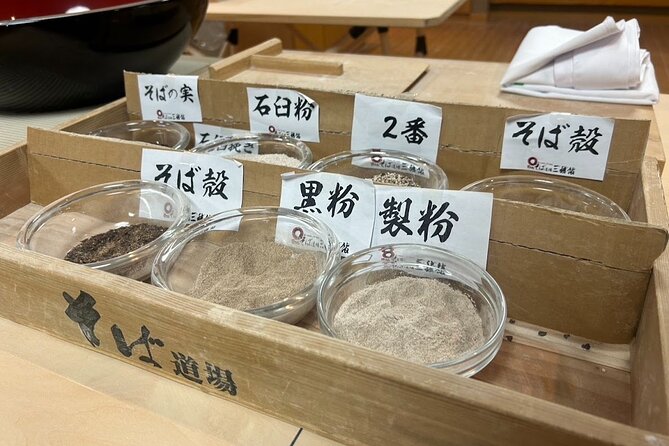
After boiling and rinsing the soba noodles, participants can savor the local flavors of Kagoshima.
They’ll enjoy the nutty taste of the soba, complemented by a dipping sauce made with Kagoshima’s renowned soy sauce and mirin. The soba is often served with tempura-fried seasonal vegetables, further highlighting the region’s fresh produce.
Participants can also sample traditional Japanese tea, providing a refreshing contrast to the heartiness of the soba.
Customizing Your Soba Noodle Dish
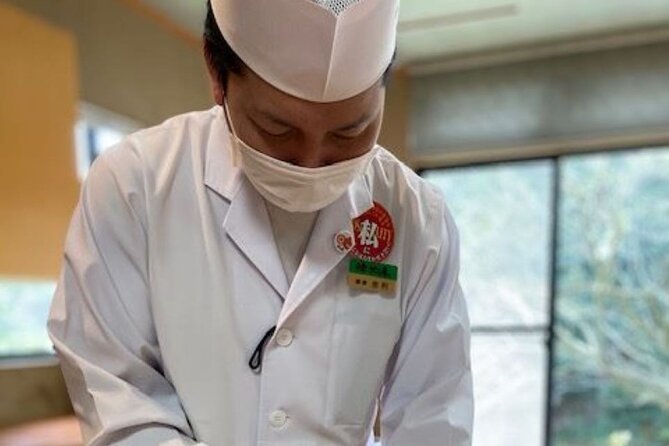
How does one customize their soba noodle dish during the Kagoshima Soba Noodle Making experience?
Participants have several options to personalize their soba creation:
-
Choose from a variety of toppings like tempura, spring onions, and grated ginger.
-
Select a dipping sauce – either a traditional tsuyu or a flavorful mentsuyu.
-
Opt for a cold or hot serving style, depending on personal preference.
-
Adjust the thickness and texture of the soba noodles by controlling the rolling and cutting process.
These customization choices allow travelers to craft a truly unique soba dish that reflects their individual tastes.
Bringing Home the Taste of Kagoshima
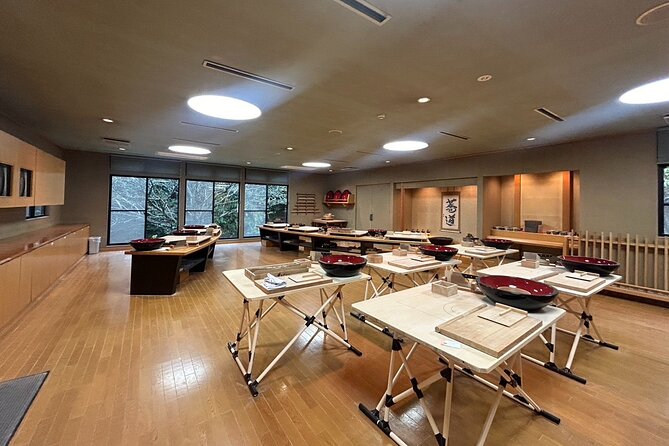
One of the highlights of the Kagoshima Soba Noodle Making experience is the opportunity to bring home the authentic flavors of Kagoshima.
Participants receive a cold storage bag to pack their freshly made soba noodles. This allows them to take their handcrafted creations back home, where they can enjoy the unique taste and texture of the locally sourced ingredients.
The soba noodles can be easily reheated and incorporated into a variety of dishes, allowing travelers to relive the experience and share the flavors of Kagoshima with family and friends.
Frequently Asked Questions
Is the Experience Suitable for Vegetarians or Vegans?
The experience is suitable for vegetarians, as they can participate in the soba noodle-making process and take home the noodles they create. However, it may not be suitable for vegans due to the potential use of eggs in the recipe.
Are There Any Dietary Restrictions or Food Allergies Accommodated?
Dietary restrictions and food allergies can be accommodated upon request. The experience provides a vegetarian option, and the instructor is happy to modify the recipe for participants with specific dietary needs. Advance notice is recommended to ensure proper accommodations.
Can the Soba Noodles Be Packaged for Takeaway?
Yes, the soba noodles can be packaged for takeaway. The experience includes a cold storage bag provided for travelers to take their freshly made noodles home with them.
Are There Any Recommendations for Nearby Attractions to Visit?
Travelers can visit the nearby historic Sengan-en Garden, a 17th-century villa with panoramic views of Kagoshima Bay. The Chiran Peace Museum for Kamikaze Pilots is also nearby, offering insights into Japan’s history.
What Is the Dress Code or Recommended Attire for the Experience?
The dress code is casual and comfortable. Participants should wear clothes they don’t mind getting a bit messy, as the soba noodle making can involve some flour and water. Closed-toe shoes are recommended for safety.
Recap
Immersing oneself in the Kagoshima soba noodle-making experience allows travelers to appreciate the region’s culinary heritage. By kneading the dough, shaping the noodles, and customizing the dish, participants gain a deeper understanding of the care and craftsmanship involved in creating authentic Kagoshima-style soba. The hands-on workshop not only offers a delicious meal but also showcases the importance of local ingredients and traditional techniques in maintaining the area’s unique culinary identity.
More Tour Reviews in Kagoshima Prefecture
- Granite Obelisk in Yakushima Full-Day Trekking Tour
- [Recommended on Arrival Date or Before Leaving!] Relaxing Water Walk on the Awakawa River With Stand up Paddleboard (Sup) [Half-Day Tour]
- Half Day Walking Tour in Yakusugi Land
- Mud Dyeing Workshop and Visit to Oshima Tsumugi Textile Factory
- 3-Day and 2-Night Amami Folksong Private Tour in Japan
- Yakushima 1 Day SHIRATANI UNSUIKYO Walking With ENGLISH Speaking Guide
Not for you? Here's more things to do in Kagoshima Prefecture we have recnetly reviewed
- 5 Best Guided Tours In Kagoshima Prefecture
- 2 Best 3 Day Tours In Kagoshima Prefecture
- Yakusugi Cedar Forest Walking Tour on Yakushima Island
- Half Day Amami Japan Boat Snorkeling Adventure
- [Recommended on Arrival Date or Before Leaving! ] Relaxing and Relaxing Water Walk Awakawa River SUP [Half Afternoon Tour]
- Explore Private Jungle Emerald Green Waterfall With Transfer
- Snorkeling With Sea Turtles
- A Traditional Tatami Room Dance by Sumiyoshi Shachu Kagoshima
- Kagoshima Soba Noodle Making With Local Ingredients
- 2 Days Satsuma Samurai Spirit Tour
- 9 Best Tours In Kagoshima Prefecture
- Yakusugi Cedar Forest Walking Tour on Yakushima Island
